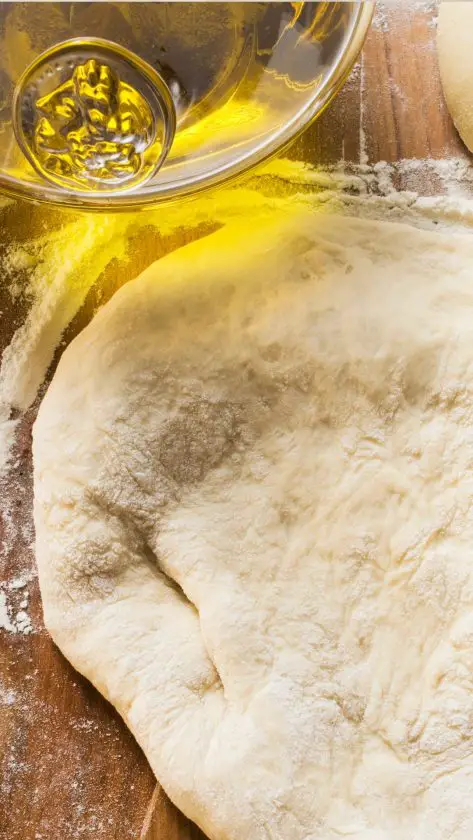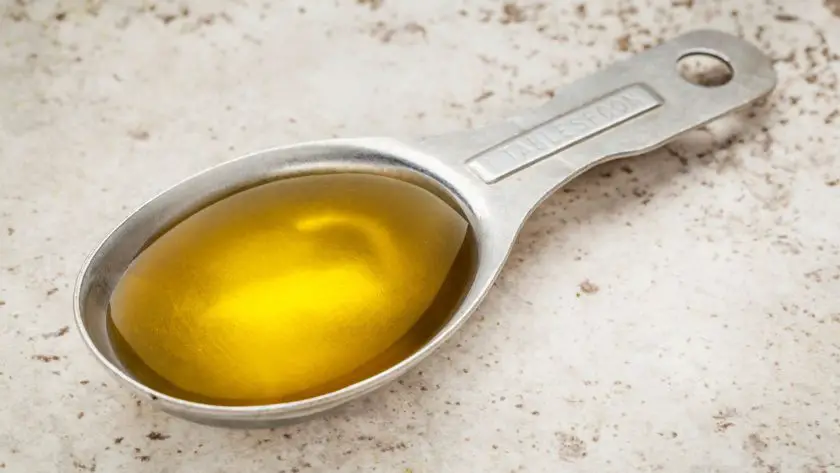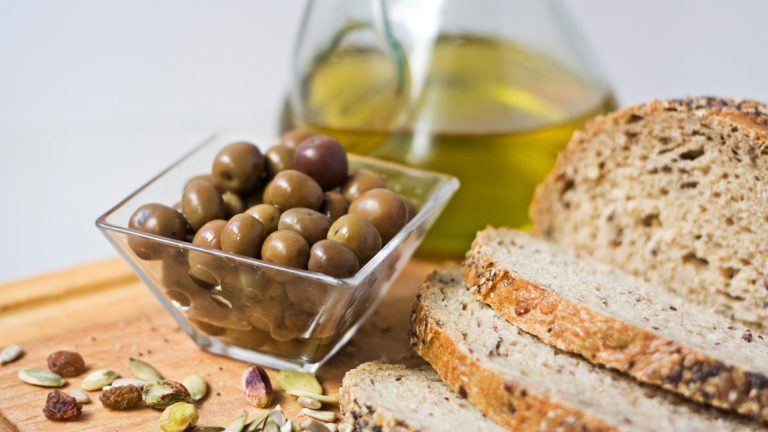For sourdough devotees, the quest for the perfect loaf is neverending. We agonize over hydration, ferment times, and baking techniques trying to achieve that balance of tang and fluff. What if one simple ingredient held the secret key? Olive oil’s rich complexity and moisture enhancing powers can elevate your sourdough to the next level.
Let’s learn about adding olive oil to sourdough to improve its nutrition, texture, and taste. With a touch of this “liquid gold,” take your loaf from flat to extraordinary. Olive oil brings sourdough salvation.

Table of Contents
- The Unique Benefits of Olive Oil in Sourdough Baking
- Choosing the Right Olive Oil
- When To Add Olive Oil To Sourdough
- How Much Olive Oil Should You Add
- Olive Oil Substitutes in Sourdough
- Recipe: Olive Oil-Infused Sourdough Bread
- Variations to Try
- The Olive Oil and Sourdough Pairing
- Adding Olive Oil To Sourdough: FAQs
The Unique Benefits of Olive Oil in Sourdough Baking
Olive oil offers several unique advantages when used in sourdough bread recipes. First, it enhances the nutritional profile of sourdough by providing heart-healthy fats. The monounsaturated fats in olive oil can help lower LDL cholesterol and blood pressure when consumed as part of a balanced diet. This makes your homemade sourdough even healthier than regular bread.
Olive oil also improves the texture of sourdough loaves. The oil tenderizes the gluten strands, leading to a softer crumb with a smoother mouthfeel. The bread will have a pleasant richness without being overly dense or heavy. Olive oil allows you to achieve the archetypal balance between a crispy crust and a light, fluffy interior.
In terms of taste, olive oil brings a fruity, peppery flavor that perfectly complements the tanginess of sourdough. It accentuates the complex aromas developed through long fermentation without overpowering them. The use of good quality extra virgin olive oil can take your sourdough to the next level by highlighting its signature sour taste.
Additionally, olive oil enables better moisture retention, keeping your loaf fresh for longer. The oil coats the starches and proteins, preventing the bread from drying out too quickly. This gives you more time to enjoy a scrumptious slice of sourdough bursting with olive-y goodness.
So if you want to make your sourdough even healthier, tastier, and with an improved texture, be sure to add some olive oil to your next loaf. A simple ingredient can make a world of difference!
Choosing the Right Olive Oil
When incorporating olive oil into your sourdough recipe, selecting the right variety is key to achieving the perfect flavor and texture. Not all olive oils are created equal, so arm yourself with knowledge before heading to the supermarket.
Extra Virgin Olive Oil
Extra virgin olive oil (EVOO) is the connoisseur’s choice for sourdough. EVOO comes from the first cold pressing of ripe olives and contains no added chemicals or heat processing. This yields an oil with a bold, fruity, peppery taste and aromatic aroma. The strong flavor profile of EVOO makes it ideal for enriching sourdough loaves. The lower acidity also helps mellow out sourdough’s sharp tang. While EVOO costs more than other varieties, a little goes a long way in sourdough recipes.
- SMOOTH EXTRA VIRGIN OLIVE OIL: Expertly crafted by The Olive Oil People, this extra virgin olive oil is made from first cold pressed olives, grown and nurtured by our family of farmers.
- SMOOTH, DELICATE TASTE: Pompeian Extra Virgin Olive Oils are ideal for any meal that starts with a sauté and ends with a drizzle. With its smooth, delicate taste, Pompeian Smooth EVOO is perfect for sautéing and stir-frying!
- 100% FARMER CRAFTED: Quality from The Olive Oil People since 1906.
- IMPORTED, FIRST COLD PRESSED EXTRA VIRGIN OLIVE OIL: Certified for Authenticity by the North American Olive Oil Association (NAOOA).
- COMMITTED TO QUALITY: Pompeian Smooth Extra Virgin Olive Oil is Naturally Gluten Free and Non-Allergenic, Kosher, and Non-GMO Verified by the Non-GMO Proje
Prices pulled from the Amazon Product Advertising API on:
Product prices and availability are accurate as of the date/time indicated and are subject to change. Any price and availability information displayed on [relevant Amazon Site(s), as applicable] at the time of purchase will apply to the purchase of this product.
Virgin Olive Oil
Virgin olive oil offers a subtler fruitiness than EVOO, with medium acidity levels. This variety still comes from the first press of ripe olives. While less assertive in sourdough, virgin olive oil provides a clean, mild olive essence. It allows the sourdough tang to take center stage. Virgin olive oil works nicely when you want just a hint of olive flavor.
Light Olive Oil
Light olive oil has undergone processing to remove defects and neutralize strong olive traits. It has very little olive aroma or taste. For sourdough baking, stick to small amounts of light olive oil for greasing pans. Overuse can yield loaves with a flat, lackluster flavor.
Understanding the unique flavor profiles of each olive oil variety helps select one that complements your ideal sourdough taste. Experiment to find your perfect match. The right olive oil takes your loaf from ho-hum to spectacular.
- EXTRA LIGHT TASTING OLIVE OIL: it bears a subtle hint of olive flavor with a delicate balance taste. The soft olive notes allows bolder ingredients to shine while maintaining its natural, delicate flavor
- 150 YEARS OF DEDICATION: Filippo Berio dedicated his life to crafting the most exquisite olive oil and each bottle bears his signature, a guarantee that it lives up to his very high standards
- SUGGESTED USES: For the benefits of olive oil without the taste, is a perfect substitute of butter, shortening, and other vegetable oils. It’s ideal for high-heat cooking like baking, frying, deep frying, stir-frying and pan frying because of relatively high smoke point (410°F-446°F)
- CHARACTERISTICS: Contain important nutrients, with good unsaturated fats and antioxidants, and FREE FROM gluten, GMOs, sugar and sodium. Kosher Certified
- PROVEN HIGH QUALITY: Our Extra Light Tasting Olive Oil meets or exceeds the International Olive Councils high standards for quality and authenticity, qualifying for the North American Olive Oil Association (NAOOA) Quality S
Prices pulled from the Amazon Product Advertising API on:
Product prices and availability are accurate as of the date/time indicated and are subject to change. Any price and availability information displayed on [relevant Amazon Site(s), as applicable] at the time of purchase will apply to the purchase of this product.
When To Add Olive Oil To Sourdough
Adding olive oil to sourdough at the right time is crucial for infusing sourdough with flavor and achieving the perfect texture. Here are some tips on optimizing olive oil incorporation throughout the baking stages.
Enhancing Dough During Mixing
One option is to add olive oil during the initial dough preparation. Mixing a tablespoon or two of olive oil into the water and flour blend allows it to fully emulsify. This helps inhibit gluten formation for a softer crumb. The olive oil also evenly distributes for well-rounded flavor. Take care not to over-oil the dough, which can impede rise.
Olive Oil for Fermentation
Another prime opportunity for olive oil addition is during fermentation. Before bulk proofing, gently fold in olive oil to coat the dough. The extended ferment time allows the olive notes to deeply permeate the developing sourdough flavor. The oil also gets a chance to condition the gluten network. Just avoid over-working the dough, which could degas rising air bubbles.
Finishing with Olive Oil
Lastly, olive oil can be used to finish a shaped loaf right before baking. Generously brush the boule or batard with oil to encourage a browned, crispy crust. The added moisture also sets up the loaf for an airy interior crumb. Drizzle on that last kiss of olive oil just before the bread goes into the blazing oven.
Leverage olive oil’s potential by incorporating it at the optimal moments throughout the baking process. Experiment to unlock your own perfect timing and flavors.
How Much Olive Oil Should You Add
When it comes to enriching your sourdough with olive oil, moderation is key. You want just enough to impart flavor and texture improvements without overpowering the bread. As a general rule, limit olive oil to around 1-3% of the total flour weight.
Minimal Olive Oil
For a subtle olive essence, add only 1% olive oil. So if your recipe calls for 500g flour, integrate 5g (about 1 tablespoon) olive oil. This whisper of olive enhances without hijacking the sourdough tang.
Moderate Olive Oil
For balanced olive intensity, aim for 2% olive oil. Using our 500g flour example, this equals 10g or 2 tablespoons olive oil. The olive presence stands out but doesn’t overwhelm the sourdough.
Max Olive Oil
On the higher end, 3% olive oil provides bold olive flavor. That’s 15g or 1 tablespoon olive oil for 500g flour. Beyond this ratio, you risk muting the sourdough notes.
Consistency Cues
Pay attention to dough consistency as you add olive oil. Too much oil can make the dough loose. Adjust water to account for the fat from olive oil. And resist kneading excessively, as olive oil can over-soften the dough when worked.
Let your taste preferences and desired texture guide you in fine-tuning the olive oil quantity. Start low and increase slowly as needed to strike that perfect balance. With a delicate hand, olive oil lifts sourdough to new heights.
What Happens If You Put Too Much Olive Oil
Adding a touch of olive oil can do wonders for your sourdough, but too much prevents the bread from reaching its peak potential. When over-oiled, your eagerly awaited loaf may emerge from the oven sunken, oily, and lacking in that tangy sourdough taste.
Excess olive oil wrecks the delicate balance between ingredients in your dough. Since oil inhibits gluten formation, an overage makes the dough overly slack. Without adequate gluten development, the dough lacks the structure to rise high and hold its shape. Your bread deflates as it proofs and bakes, resulting in a squat, dense loaf.
Too much oil also impedes yeast activity during fermentation. The oil coating prevents water from fully hydrating the yeast and gluten. With poor fermentation, you miss out on sourdough’s characteristic tang. The bread tastes flat and one-dimensional.
Additionally, excess oil creates an uneven crumb riddled with tunnels and holes. During baking, oil pockets dispersed throughout the dough can leave gaps in the crumb when they melt away. This crumb is more cake-like than the springy, chewy interior you hope for with sourdough.
While a touch enhances, too much olive oil ruins the rise, taste, and texture of sourdough bread. Start with small amounts around 1-2% of flour weight. You can always add more oil after testing for dough consistency and flavor. With olive oil, less brings you much closer to sourdough success.

Olive Oil Substitutes in Sourdough
When baking sourdough, olive oil adds tremendous flavor and beneficial fat. But you may want to experiment with substitutes for dietary needs or flavor preferences. Several oils and fats can stand in for olive oil in sourdough recipes.
Alternative Plant-Based Oils
Avocado, walnut, grapeseed, sunflower, and coconut oils all provide plant-based swaps for olive oil in sourdough. Their subtle, neutral flavors allow the sour tang to shine. These oils add moisture and richness without overpowering. For nuttier flavor, toasted sesame or peanut oil offer robust options. Take care with coconut oil, which solidifies when cool – melt it first before adding to dough.
Butter
For a dairy twist, butter makes a delicious olive oil alternative in sourdough recipes. It contributes moisture along with a creamy, mellow taste. Substitute butter at a 1:1 ratio – unlike oil, you don’t need to decrease hydration. When fermenting, the tang balances butter’s richness. For ultimate flavor, use high-fat European-style butter. Clarified butter works nicely too.
Lard or Bacon Drippings
For the adventurous baker, rendered lard or bacon drippings provide a smoky, porky alternative to olive oil in sourdough loaf. The rich savoriness complements the acidic tang. Brush lard on before baking for perfect browning and crunch. Limit to 1-2 tablespoons per loaf to avoid greasiness. Pasture-raised lard offers the best depth.
With some creative substitutions, your olive oil-free sourdough will still rise beautifully and taste delicious. Experiment with oils, fats and flavors to discover your perfect match. The options are limitless for putting your own spin on sourdough.

Recipe: Olive Oil-Infused Sourdough Bread
This section provides a basic olive oil-infused sourdough bread recipe along with suggestions for fun variations to try.
Basic Olive Oil Sourdough
A good basic recipe is the perfect starting point for baking delicious olive oil-infused sourdough bread. Here is a simple recipe to create a classic olive oil sourdough loaf.
Ingredients:
- 500g bread flour
- 350g water
- 100g mature sourdough starter
- 10g salt
- 2 tbsp olive oil (use a fruity extra virgin olive oil)
Instructions:
- Combine the bread flour, water, and mature sourdough starter in a large bowl. Mix well until combined into a shaggy dough.
- Cover and let rest for 30 minutes. This autolyse allows the flour to fully hydrate.
- Add the salt and olive oil. Knead the dough for 5-7 minutes until smooth and elastic.
- Place dough in a lightly oiled bowl. Cover and let proof at room temperature for 4-6 hours until doubled in size.
- Turn out the dough onto a clean work surface. Gently shape into a round boule.
- Place seam side up in a floured proofing basket or towel lined bowl. Cover and proof for another 60-90 minutes.
- Preheat oven to 450°F. Place a cast iron dutch oven with lid in the oven as it heats up.
- Carefully turn out the dough into the hot dutch oven. Score the top with 1/4 inch cuts.
- Bake covered for 30 minutes. Uncover and bake 10 more minutes until deep brown.
- Let cool before slicing to enjoy your fresh olive oil sourdough!
Variations to Try
Flavor Variations
While the basic olive oil sourdough delivers incredible flavor, you can also try these easy variations:
- Herbed Olive Oil Bread: Add 2 tsp each dried basil, oregano, thyme to the dough.
- Lemon-Olive Oil Bread: Add the zest of 1 lemon to the dough.
- Olive-Rosemary Bread: Add 2 tsp minced fresh rosemary to the dough.
- Kalamata Olive Bread: Add 1/3 cup chopped kalamata olives to the dough.
- Sun-dried Tomato & Olive Bread: Add 1/4 cup rehydrated sun-dried tomatoes.
- Olive Focaccia: Shape into a large flattened round. Drizzle with olive oil and sprinkle with sea salt before baking.
- Maltese Bread: This recipe actually also features olive oil as a key ingredient to this Mediterranean bread!
Feel free to mix and match herbs, olives, zests and other ingredients to create your own unique olive oil-infused sourdough bread. A world of flavors awaits your artisanal creations!
Shaping Variations
Beyond flavors, olive oil enables you to get creative with shaping your sourdough loaf:
- Round Boule: The classic round shape, great for sandwiches.
- Oblong Batard: An elegant elongated oval loaf.
- Braided Bread: Divide dough into three pieces then braid together.
- Rolls: Shape dough into round individual rolls before baking.
- Olive Wreath: Roll out dough into an oval then form into a circle wreath shape.
With the versatility of olive oil, you can craft your sourdough into a myriad of shapes and sizes. Shape small rolls for dinner or a large wreath for a show-stopping centerpiece.
With my basic olive oil sourdough recipe as your guide, unleash your inner artisan to bake up the perfect loaf infused with your favorite flavors, herbs and shapes. The possibilities for delicious olive oil sourdough creations are endless.
The Olive Oil and Sourdough Pairing
One truth rises above the rest: Not all loaves are created equal. The humble baker who harnesses the powers of olive oil is elevated to the status of sourdough artisan.
This is the path to mastering one of baking’s highest arts. And you need only one golden ingredient – olive oil – to guide you there. So begin your journey and see where the winding road of olive oil takes you next. The power is now in your able hands. Wield it wisely and change the world, one perfect loaf at a time.
Adding Olive Oil To Sourdough: FAQs
What does adding oil to bread dough do?
Adding oil to bread dough serves several purposes. It softens the dough, making it easier to knead and shape. Oil also enhances the dough’s ability to retain moisture and gas pockets, resulting in a lighter texture. Finally, oil imparts flavor and richness to the baked bread.
Does olive oil stop dough from rising?
No, adding a small amount of olive oil to bread dough does not prevent the dough from rising properly. The oil helps make the dough more pliable and can enhance flavor and texture. Too much oil may slow rising time slightly but will not significantly inhibit yeast activity and dough rise. A tablespoon or two per loaf is usually sufficient.
What is the best oil for sourdough bread?
The best oils for sourdough bread are lighter, neutral-flavored oils that won’t overpower the sourdough taste. Good options include canola, vegetable, grapeseed, or light olive oil. Avoid heavier oils like extra virgin olive oil or nut oils as they can impart too strong a flavor for the subtle sourdough tang. A tablespoon or two per loaf allows the sourdough flavor to shine.

Olive Oil-Infused Sourdough Bread
A good basic recipe is the perfect starting point for baking delicious olive oil-infused sourdough bread.
- Total Time: 8.5 hrs
- Yield: 1 loaf 1x
Ingredients
- 500g bread flour
- 350g water
- 100g mature sourdough starter
- 10g salt
- 2 tbsp olive oil (use a fruity extra virgin olive oil)
Instructions
- Combine the bread flour, water, and mature sourdough starter in a large bowl. Mix well until combined into a shaggy dough.
- Cover and let rest for 30 minutes. This autolyse allows the flour to fully hydrate.
- Add the salt and olive oil. Knead the dough for 5-7 minutes until smooth and elastic.
- Place dough in a lightly oiled bowl. Cover and let proof at room temperature for 4-6 hours until doubled in size.
- Turn out the dough onto a clean work surface. Gently shape into a round boule.
- Place seam side up in a floured proofing basket or towel lined bowl. Cover and proof for another 60-90 minutes.
- Preheat oven to 450°F. Place a cast iron dutch oven with lid in the oven as it heats up.
- Carefully turn out the dough into the hot dutch oven. Score the top with 1/4 inch cuts.
- Bake covered for 30 minutes. Uncover and bake 10 more minutes until deep brown.
- Let cool before slicing to enjoy your fresh olive oil sourdough!
- Prep Time: 5 hrs 55 mins
- Cook Time: 40 mins
- Category: bread




![[Video] From The Seed To The Peasant Bakery With Nicolas Supiot 94 [video] from the seed to the peasant bakery with nicolas supiot](https://www.mydailysourdoughbread.com/wp-content/uploads/2022/11/image-18-120x120.jpeg)

![Is Keto Sourdough Bread Low Carb - What You Need To Know [Plus Bonus Recipe] 96 Is keto sourdough bread low carb - what you need to know [plus bonus recipe]](https://www.mydailysourdoughbread.com/wp-content/uploads/2022/09/CD-blog-images-2022-09-28T221612.311-e1665964918416-120x120.jpg)

